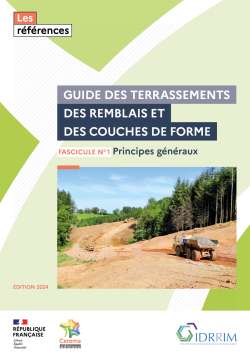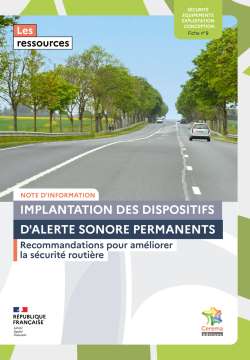
Designing single-Lane dual Carriageways - 2x1 lane
2011 edition (2021 update)
As an addition to established reference documents such as the ICTAAL instruction, the ARP and the VSA guides, this guide is intended for project owners and project managers, and also for consulting firms that wish or need to design interurban roads with two separate single-lane carriageways (2x1 lane).
The characteristics described correspond to new roads outside urban areas and offering no local resident access; they therefore completely or partially exclude some categories of users or vehicles. As such, they are usually qualified as expressways. Adaptation of the characteristics to roads providing local resident access, without the systematic use of barriers to separate the opposing directions of travel, is not covered in this guide. Such adaptation has yet to be examined and its principle validated. The associated technical provisions, as well as those relating to the re-examination of existing roads, may be addressed in subsequent publications.
Foreword*
General design
- Functions of single-lane dual carriageways
- Uses of single-lane dual carriageways
- Speed limit
- Cross-section
Service level and overtaking sections
Length and siting of overtaking sections* - Configuration of interchange points
- Rest areas and service areas
- Considerations for operation and maintenance
- Change in road type
- Public transport stops and carpooling areas
- Illustrations of road treatment*
Example of a single-lane dual carriageway with a connection function
Example of a single-lane dual carriageway with a distribution function
Visibility*
- General provisions
- Visibility on link sections
- Visibility on the approach to a critical point
Visibility of an exit
Visibility of an entrance
Visibility on the approach to and at the entrance of a roundabout
Visibility of a lane reduction transition
Visibility on the approach to and along a non-standard engineering structure (excluding underground structures)
Visibility of a refuge
Visibility of an arrester bed
Visibility on the approach to and inside underground engineering structures
Visibility of service access lanes
Visibility on the approach to a toll plaza
Visibility on bends
Visibility on slip roads
Visibility under structures
Visibility of pedestrian crossings - Visibility on a connection road between a single-lane dual carriageway and the local road network
- Cross-section
- Cross-section on link sections
Usable width
Carriageway
Central reservation
Verge* - Cross-section across engineering structures
Cross-section across a standard engineering structure
Cross-section across a non-standard engineering structure*
Cross-section across an underground structure - Change in cross-section
Creation of an additional lane
Removal of a lane (lane reduction transition)* - Crossfall
Conventional provisions
Superelevation values
Change in superelevation*
Horizontal and vertical alignment
- Horizontal alignment
Minimum radius values
Transition curves
Sequencing of horizontal alignment elements - Vertical alignment
Minimum radius values*
Sections subject to large level differences*
Siting an overtaking section resulting from vertical alignment - Coordination of horizontal and vertical alignment
Interchanges and access points
- Siting of access points*
Distance between two access points on a single-lane dual carriageway
Positioning of access points in relation to overtaking sections - Entrance system geometry
Merging entrance system
Additional entrance lane system - Exit system geometry
Exit via an exit taper
Exit via lane assignment - Roundabouts
- Geometry of roads linking the local road network to a single-lane dual carriageway
Facilities and user services
- Safety and operating facilities
Safety barriers
Traffic signs and markings*
Anti-glare measures
Refuges*
Steep slopes*
Fencing
Street lighting* - Fixed operating facilities
Toll areas
Service and emergency access points - Environmental facilities
Surface water collection and drainage
Architectural and landscaping treatment
Noise abatement facilities - Ancillary areas
- Real-time traffic information
Appendices*
- Bibliography
- Glossary
*: updated in 2021





















